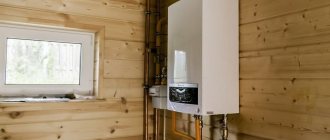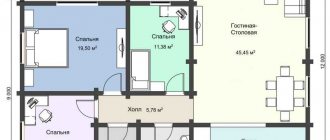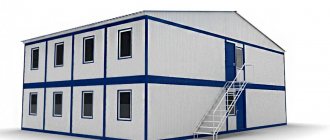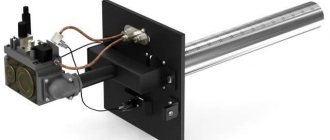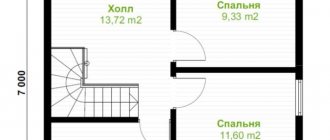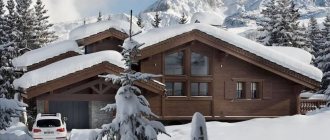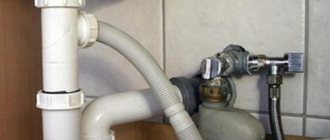Every year the cost of utilities, be it electricity or hot water supply, is growing rapidly. Unfortunately, this is happening both due to the usual inflation and rising energy prices, and because of the banal greed of service providers. That is why today more and more people are looking for an alternative that allows them to reduce fees, which, apparently, will become simply unaffordable in a few years.
Autonomous boiler room in an apartment building
And many people find a solution to this problem. One boiler room per apartment building is able to fully satisfy the needs of all residents, providing them with high-quality heating, as well as supplying the required amount of hot water. However, installing your own autonomous boiler room is an extremely serious decision that cannot be made without thinking everything through and weighing the pros and cons a hundred times. And to do this, you should know both the pros and cons of this solution.
Using what criteria to choose
There are 3 main criteria for this process:
- Volume. You should not set the device to the maximum value for this value. This may lead to financial difficulties in the future. Since a container of sufficient volume will use more water, the bill for its consumption will be higher. It is worth remembering that the larger the volume of the installation, the more it will come into contact with the coil, which can lead to heating of the coolant.
- Power. This criterion affects water heating. For a full heating process, a water heater with an indicator of 8-12 kW is suitable.
- Diameter. This criterion depends on the area of the room where the device is installed.
Installation and operation of a heating boiler
Boiler in the heating system
After completing all the necessary calculations of the boiler power and its volume, you can begin to integrate the device into the heating system
An important task is to determine the installation location. Having decided on the purpose of the boiler in the heating system, you need to read the instructions for its installation
The best option would be installation in close proximity to the boiler. In this case, the transfer of thermal energy from the coolant to water is most effective.
But at the same time, you may encounter the following difficulties in organizing heating using a boiler:
- DHW system supply. In a heating system with a solid fuel boiler, it is most convenient to place the boiler directly in the boiler room. But then to supply heated water to the premises you will need a separate pump and control devices for it;
- Large capacity capacity. if heating through a boiler is planned for large residential areas. There is a problem with the placement of the heating element;
- Electrical supply to ensure the operation of the heating element. For the normal functioning of the boiler for heating a private house, it is also recommended to install an autonomous source of electricity.
Having resolved these issues, you can proceed directly to installation.
The heating water temperature through the boiler is controlled using an installed thermometer. It is not included in the standard package and therefore must be purchased separately.
Installation of a heating storage tank
To install the heat accumulator, it is necessary to prepare a flat area in advance. Its heavy weight should be taken into account - if necessary, a separate foundation is made or the floors are reinforced.
The optimal installation option is on a separate platform. This way you can avoid contact of the housing with the concrete surface, which will reduce heat losses in the electric heating boiler. Almost all manufacturers make containers with special legs. If they are missing, it is recommended to install insulation on the floor.
The procedure for connecting the boiler to the heating system is to perform the following steps:
After installing the container, you need to check its position relative to the horizon. No deviations are allowed. Connect to heating
It is important that the diameter of the pipes is equal. Otherwise, after connecting the boiler to the heating system, excess hydraulic resistance will appear. If installation is carried out in an unheated room, the boiler body is insulated. A connection to the hot water supply is made so that the boiler works not only for heating, but also for hot water supply.
Upon completion of this work, you need to check the tightness of all connections and start the heating system. It is recommended to measure the temperature of the water in the tank and the coolant in the pipes within 2-3 weeks after the boiler is turned off. This way you can determine the actual time of maintaining the required heating level in the heating circuit from the boiler.
In order to make full heating from a boiler, it is not recommended to use antifreeze. It is characterized by a relatively low heat capacity, which will affect the transfer of heat to water and back to the coolant.
Conditions for proper operation of the boiler
Scale on the heating element of the boiler
Servicing a storage tank is practically no different from carrying out the necessary procedures to maintain the functionality of any electric boiler with heating elements. And in this case, in order for the boiler to work normally in the heating system of a private home, you must follow the manufacturer’s recommendations.
This can be ensured even before the heat supply from the boiler is made. It is best to purchase models with the so-called “dry heating element”. On it, scale formation occurs much more slowly. You should also pre-filter the water before feeding it into the storage tank.
In addition to these procedures, you must do the following:
- Once a month, check the integrity of the thermal insulation of the structure;
- Monitor the duration of maintaining the coolant temperature during the heat supply mode through the boiler. The difference between calculated and actual indicators should not exceed 15%;
- Checking the tightness of connections. It is recommended to replace the gaskets before each heating season. This way you can achieve more reliable heating of a private home using a boiler.
The control unit of some models is sensitive to voltage changes. To avoid damage to this expensive device, you should connect a stabilizer for the boiler in the heating system.
To clean the heating element from scale, you must dismantle it. But before that, you need to find out from the seller whether the factory warranty is still valid.
What a boiler room should look like
In principle, no matter the size of such premises, they are subject to certain technological rules:
- Each room of individual houses must have finishing that matches the project. For this purpose, special materials are used that are highly moisture resistant. They should not be afraid of large temperature changes.
- Every boiler room project must include a powerful ventilation system.
Detailed diagram of the boiler room arrangement - A sewer drain must be installed in the boiler room.
- Fire safety requirements must be strictly followed.
- For electrical equipment, a special package is included in the house design.
A separate room is specially designed for an apartment building.
For private houses, the best location for the boiler room is the basement; the ground floor is also suitable.
Preparatory work before installing the boiler
Self-installation of an electric water heater will cost you less than the services of specialists. On average, the work will take about two hours. But when preparing for installation and directly during the work process, safety regulations must be observed.
- First of all, you should decide on the boiler model: what kind of system it should be - flow-through or storage, how many liters it is designed for, how it will be mounted - horizontally or vertically, on the wall or under the sink, etc.
- The next step is to create a connection diagram for the device on paper indicating the connection of hot and cold water. Then you need to do the following:
- make room for the water heater and work;
- check the strength of the wall for the ability to withstand the weight with a double margin (for example, if the boiler has a volume of 50 liters, then fasteners with a weight equal to 100 kg plus the weight of the empty boiler are required);
- since the water heater is a very powerful consumer of energy, it is necessary to determine in advance the type of wiring (aluminum or copper) and the cross-section of the cable laid in the walls, and also evaluate the ability of the wiring to withstand the load of an electric boiler (for example, to connect a 2 kW boiler, a copper cable with a cross-section of from 2.5 mm2);
- check the condition of water pipes and risers (especially for old houses) - they must be in good condition and have points for connecting a water heater.
- Before you start installing the boiler, you need to read the instructions to understand the features of the model, then turn off the electricity and shut off the pipes supplying hot water. It should be remembered that if you live in a multi-storey building, this will temporarily deprive residents of other apartments of hot water, so you need to carefully prepare for the work in order to complete it quickly.
You can check the strength of the wall in the following way: mount the fasteners that come with the boiler and hang two bags of cement on it. If the mount can cope with such a load, then it will be able to withstand a water heater that weighs half as much.
Particular attention should be paid to checking the wall for strength when installing a large 150-liter boiler. Such a unit is fastened using expansion metal anchor bolts or special durable hooks
It is recommended to use anchors with a length of 100 mm and a diameter of 10 mm.
It should be borne in mind that installing the water heater will require the efforts of two people, since this process is quite labor-intensive. Typically, the boiler is mounted in the bathroom or toilet directly above the toilet. As a rule, this place is not used in any way. At the same time, a free approach to it must be ensured.
In a small room, to save useful space, the boiler is usually placed horizontally. A small-volume water heater is attached to the wall, and units with a volume of 200 liters or more are installed on the floor.
Equipment options
The type of fuel and device affects the conditions of the premises being used. When choosing an equipment option, you first need to provide for all the nuances and arrange the room in accordance with all established requirements for safe operation.
Modular
This option is very rare and is used if it is not possible to use other options. Available ready to run.
Small solid fuel modular boiler room Source termico.com.ua
See also: Catalog of companies that specialize in autonomous gasification of country houses
Represents the following device:
- container up to 2.5 m long;
- of varying power, but are mainly used for buildings with an area of no more than 1300 m³;
- The walls of the device are double, with insulation;
- diesel and solid fuel are used;
- It is connected to the house through a pipe, it must have insulation.
It is advisable to place it nearby and can be transported. Before use, it is connected to the power supply and the system is filled with water. Often these models have backup power.
Peculiarities
Unlike conventional water heating devices, this device has an inlet pipe (for cold water) mounted at the bottom of the storage tank, and an outlet pipe (for hot water) at the top.
Thus, the liquid must circulate in a closed heating circuit at a fixed temperature, which is achieved in the upper part of the tank.
Indirect heating boiler with connection to the boiler
The main difference between such a device and a conventional water heater for heating is the presence of an external source of heating the coolant. This could be solar panels, a boiler, central heating.
From such an auxiliary source, a coolant passes through a coil passing through the inside of the boiler, which, in turn, heats the liquid in the tank.
This system is protected by a thermal insulation layer.
Electric storage boiler design
Knowledge of the structure and operating principle of the unit will allow you to avoid annoying mistakes during installation and operation, and this will increase the duration and safety of use.
What elements does an electric boiler consist of?
- Bracket for fixing the boiler to the supporting surface. Placed at the top of the device, it ensures reliable fastening of the boiler. It is made of thick sheet steel and welded to the outer casing by contact welding.
- Cold and hot water supply pipes. The cold water pipe has a short length and a jet divider. Due to this design, cold water is evenly distributed in the lower volume and the jet pressure does not mix with heated water. The heated water rises due to the difference in the densities of cold and hot water. The hot water intake pipe has an increased length; the intake occurs in the upper, most heated part of the volume.
- A layer of thermal insulation. A very important element of the boiler; heat saving indicators largely depend on it. It is made from various modifications of polystyrene foam.
- Thermostat. Adjusts temperature values, automatically turns on/off power. It will be placed in the lower part, you need to remember this when adjusting the water heating temperature.
- Internal reservoir. It can be made of stainless steel (expensive models) or ordinary sheet steel with an anti-corrosion coating.
- A heating element. Power 1.5–2.0 kW, can be “wet” or “dry”.
- Magnesium anode. Purpose – to reduce corrosion processes in the internal tank. How does it work? Water contains oxygen, which oxidizes iron. Magnesium is highly active and is the first to react with oxygen, due to this its concentration in water decreases and steel rusts more slowly. The frequency of replacing the magnesium anode depends on the frequency of use of the boiler and averages 5–8 years.
- Thermometer. An ordinary bimetallic thermometer is used, the reading accuracy is ±2–3°C. Some modern models have electronic control units, but this does not affect the quality of operation. But the cost of the boiler increases significantly.
- Indicator light. It turns on when voltage is applied to the heating element and turns off simultaneously with it.
- External body. Coated with durable powder paints that reliably protect the metal from the negative influence of external factors.
- Safety and check valves. Manufactured in one housing, they control the pressure in the boiler and protect against excessive pressure increases during water heating. The check valve performs two functions: it prevents emergency exposure of the heating elements and prevents heated water from getting back into the water supply. In the absence of a valve, heated water flows not only for its intended purpose, but also into the entire water supply system.
- Plastic coupling. Used when connecting the boiler to metal pipes, it reduces the voltage during a short circuit of the heating element. But it cannot completely protect users, we will talk about this in the article below.
Most boilers consist of such elements. Minor technical differences do not affect the installation process.
Choosing a gas boiler
There are no fundamental differences between gas boilers; globally they differ only in the installation method; there are floor-standing boilers that require additional space, a fireproof floor covering and are more suitable for owners of private houses.
The fundamental criterion when choosing a boiler is its power. A large power indicator can tighten the requirements for room equipment, so you should not take this parameter with a reserve. The power must be sufficient for active heating of the apartment, and hot water must be supplied at the same time.
The heat exchanger material affects the heating efficiency, but remains an insignificant parameter; the service life of the heat exchanger is much more important.
It is also important to choose a boiler from a reliable manufacturer, preferably a foreign one. Many domestic units are capable of ensuring normal operation, but the reliability and quality of foreign equipment elements is superior to domestic analogues
Price also significantly influences your choice. The optimal choice is a high-quality product without excessive power indicators in the mid-high price range.
Also, boilers can be of two types: single-circuit and double-circuit. Each circuit allows the connection of a piping system. Accordingly, single-circuit equipment is designed only for space heating, while double-circuit equipment will provide heat supply and hot water supply.
DIY heating boiler
It should be noted that the cost of factory-made boiler models for heating a dacha is quite high - from 7,000 rubles. and more. An alternative option is to make the structure yourself.
You can use any steel container for this.
It is important that its volume corresponds to the calculated one. To organize heat supply circuits from a homemade boiler, you will need the following components:
- Tank. It is best to order a stainless steel structure or make it yourself. The body must have holes for soldering inlet and outlet pipes;
- Coil. The best option is to install a copper structure. This material has optimal parameters for the transfer of thermal energy;
- Fastening pipes for connecting to heating and hot water supply.
To ensure thermal insulation, it is recommended to make a double casing. Glass wool or basalt insulation is installed between the walls. The recommended layer thickness is 5 cm. The installation and commissioning procedure is no different from the factory models.
How effective is the use of a boiler in heating a home? It all depends on the correct calculations of the parameters of the entire system. Only after calculating the optimal characteristics and testing them in practice can we talk about the real efficiency of the boiler installation.
The video shows an example of using a boiler in a heating system.
Boilers for heating structures
On the roofs of modern urban apartment buildings, only those boilers that meet the requirements of SNiP II-35-76 can be installed. This equipment has a high level of automation. Without the mandatory presence of employees around the clock, you can organize the ideal level of home heating.
When choosing modern heating system boilers, preference should be given to equipment from European companies:
- Futera;
- Wessex;
- Viessmann;
- Protherm;
- Vaillant;
- Lochinvar.
When choosing the best option, you must rely on the level of thermal power of the device and the availability of appropriate licenses. Boilers must be registered with Rostekhnadzor. This confirms the complete adaptation of the devices to operating conditions in the Russian Federation.
Using a boiler for a water supply system to heat a house
One of the frequently asked questions regarding the use of a boiler in a heating system is the following: can a boiler, which is designed to simply heat water for domestic needs, be used in a heating system. There is no definite answer to this question - it all depends on how extensive the heating system itself is and what additional equipment is used.
A boiler for a water supply system is different in that it has both holes (both the cold water inlet and the hot water outlet) located at the bottom, and both of these holes have a small diameter (most often it is 0.5 inches or approximately 1.2 cm ).
This arrangement of holes eliminates the possibility of water moving through the heating system on its own, since here cold water will not constantly “drive” hot water out of the tank and force it to move through the pipes. But, in general, such a boiler can be used in a heating system if it is supplemented with a circulation pump, which will be “responsible” for the movement of water through the heating system. The effectiveness of such a system depends on several factors:
- depends on how powerful the boiler itself is. Suitable power is usually determined at the rate of 1 kW per 10 square meters of heated area.
- depending on how powerful the circulation pump is
- depends on how extensive the heating system of the house is. It is best if it does not have many branches.
As for the type of boiler, you can use both instantaneous and storage water heaters.
So, heating a house with a boiler is not a fantasy at all, but a completely viable option for installing a heating system. The main thing when creating such a system is to accurately calculate the required boiler power, based on the size of the house. In some cases (for example, if the house area is large enough), the efficiency of the system can be increased by expanding the water inlet and outlet, as well as by upgrading the boiler itself to increase its power.
07/07/2013 at 20:07
Why are rooftop boiler rooms more popular?
For the reasons given above, roof-mounted boiler rooms for apartment buildings are more popular. There are no restrictions on the type of fuel used. Therefore, in most cases, gas boilers can be seen on roofs - economical, efficient, and easy to use.
Rooftop boiler room operation diagram
A serious plus: there is no need to rack your brains about ensuring sufficient ventilation is required for each boiler room. There are usually no difficulties when calculating and installing chimneys. Using gas as the main energy carrier greatly simplifies the operation process. Installing specialized additional equipment allows you to start the heating boiler automatically as soon as the room temperature reaches the set minimum. As soon as the temperature rises to the required level, the boiler will immediately turn off, thereby saving a large amount of fuel and, accordingly, money for apartment owners.
In other words, the need for the constant presence of a dispatcher becomes unnecessary: the entire process of operation of the heating boiler becomes automated.
Modern gas boiler rooms are as easy to use as possible.
Therefore, you don’t have to be a certified engineer to understand its structure. Any of the residents of the house can turn the boiler on or off, as well as increase or decrease its power.
Features of mounting a boiler on a thin wall
Ideally, the water heater should be mounted on strong brick, concrete or block walls, since the device, together with water, has quite a lot of weight. But sometimes the device needs to be hung on a thin plasterboard, frame, wood, aerated concrete or foam block base. In this case, you will need to strengthen the wall and use special fasteners.
The water heater cannot be mounted directly on a wooden wall for fire safety reasons. First, it needs to be well insulated from heat, for example, with profiled iron, which is used for roofing.
In other cases, special fastenings are used:
- spiral nylon dowels;
- metal fasteners for mounting boilers with a capacity of 100 liters or more.
If you plan to hang the water heater on a wall made of foam concrete blocks, you will need metal dowels or special chemical (adhesive) anchors for foam concrete. Chemical anchor is a universal fastener that can withstand high loads. It is environmentally safe and resistant to low temperatures.
Attachment to an adhesive anchor is carried out in the following way:
- A hole is drilled to expand the channel by rotating the drill at an angle in different directions.
- Concrete dust is removed from the hole.
- The hole is filled with a quick-hardening mixture, into which a fastening sleeve or threaded pin is inserted.
The resulting cone-shaped plug provides fairly high fastening strength.
Summarizing
It is forbidden to install gas equipment yourself, since the requirements for tightness of connections are high and special equipment and specific knowledge are required. The installation of other types of boilers should also be entrusted to professionals, although it is less complicated. But some work is easy to do yourself, saving a lot of money.
Prepare the room by carefully leveling the surfaces of the walls and floor. After this, proceed to plastering, finishing, painting. It is acceptable to paint putty walls with water-based paints that do not emit toxic substances when heated.
Perform any work related to the construction of a boiler room and installation of heating equipment responsibly, in compliance with the described standards and regulations. Be especially careful when electrifying a room. Before starting installation work, carefully study the technical documentation for the boiler and the regulations governing the arrangement of the boiler room.
Having difficulties choosing boiler equipment for a private home? Oventrop specialists will select for you all the thermal units that meet the technical parameters, complying with all standards and requirements accordingly. For additional advice on issues of interest, send us a message or call us.
Is it possible to use a hot water boiler in a heating system?
In order to fully understand what kind of device this is, you need to understand all the nuances.
What is the device
Visually, the heating boiler looks like a container of quite large volume. A heat source is located inside or below it.
Design and technical characteristics
On the outer body of the device there is a pressure sensor and an electronic-mechanical system for controlling the boiler. Next, there is a layer of thermal insulation that separates the housing wall and the storage tank, and allows you to retain heat.
Photo 1. Indirect heating boiler model 702.1, capacity - 712 l, Italy.
It is advisable to choose the volume of the storage tank in which water will accumulate and warm up in the range of 200-300 liters. Lower values of tank capacity should not be considered, since this will not be enough to heat even a small area.
Water is heated using a tubular electric heater with a power of at least 8-12 kW.
Attention! It is important to take this indicator into account, since if it is lower, the equipment will not cope with heating, and there will be a need for round-the-clock operation of the device
What is it for?
After the storage tank is filled, the heating elements located inside it begin to heat the water to the set temperature. As the required level in degrees is reached, the liquid begins to flow through the pipes into the pipes of the main heating system.
Although the principle of operation of a heating boiler is quite simple, it is important to remember about the features of the preparatory process:
- create a closed circulation circuit;
- foresee the possibility of adding liquid to the coolant from water supply systems;
- install a pump that regulates the stable movement of water through the pipes, shut-off valves, and an expansion tank;
- establish a water filtration structure, the liquid should circulate along the circuit in a purified form, without impurities.
The heating elements built into the boiler control fluctuations in the temperature of the device. As soon as the user-defined value in degrees is reached, the system automatically turns off. If the water cools down, then the reverse process occurs: it starts heating again.
Malfunctions
What problems in the operation of the water supply system can the apartment owner eliminate on his own? Here are some of the most typical situations.
Valves leaking
Description: leakage along the stem of screw valves.
A typical leak location is shown by an arrow.
- Reason: partial wear of the oil seal or wear of the rubber O-ring.
- Solution: open the valve knob all the way. In this case, the thread on the rod will tighten the seal from below, and the leak will stop.
Crane noise
Description: when you open a hot or (less often) cold water tap, you hear a loud noise and feel the vibration of the mixer. Alternatively, your neighbors faucet could be the source of the noise.
A noisy neighbor's faucet can become a source of a lot of negative emotions.
Cause: a deformed and crushed gasket on the screw valve in the half-open position causes a continuous series of water hammers. Its valve closes the seat in the mixer body at intervals of a fraction of a second. In hot water, the pressure is usually noticeably higher, so the effect is more pronounced.
Solution:
- Shut off the water to the apartment;
- Turn out the problematic valve housing;
- Replace the gasket with a new one;
- Use scissors to remove the chamfer from the new gasket. The removed chamfer will prevent the valve from beating in a turbulent stream of water in the future.
Replacing the gasket on the screw valve
By the way: ceramic faucets are fully compatible with screw threaded faucets, and do not have the described problem.
The photo shows a ceramic crane box
Cold heated towel rail
- Description : The heated towel rail in your bathroom has cooled down and is not heating up.
- Reason : if the water supply scheme of a residential apartment building uses continuous circulation of hot water, the air remaining in the jumper between the risers after water is discharged (for example, for inspection and repair of shut-off valves) is to blame.
- Solution : go up to the top floor and ask your neighbors to bleed the air from the jumper between the DHW risers and heated towel rails.
If for some reason this cannot be done, the problem can be solved from the basement:
- Shut off the DHW riser passing through your apartment, to which your connections are connected;
- Go up to the apartment and open the hot water taps all the way;
- After all the air has come out of the riser through them, close the taps and open the tap on the riser.
If a vent is installed on the riser, it can be diverted directly from the basement
A caveat: immediately after the end of the heating season, there may be no pressure difference between the threads of the heating main. In this case, the heated towel rails will be cold even if there are no air pockets in the risers.
Immediately after the end of the heating season, the difference between the lines of the route may be zero
Boiler insulation
In order for the boiler to retain heat better, it must be wrapped in polypropylene foam, polyurethane foam or isolon. The insulating material is fixed with glue or wire. Thermal insulation of the entire surface of the boiler not only helps to retain heat, but also reduces the heating time of water by increasing the efficiency of the coolant. High-quality insulation will not allow the water to cool quickly.
The second way to insulate a boiler is to place a smaller capacity container inside a large tank. The resulting space acts as insulation.
Still, if you realize that you are unable to install the boiler yourself, or there is a need to replace the pipes due to wear, contact a specialist. Their services will not cost you too much: dismantling an old water heater - about 500 rubles, installing and connecting a new device - about 7,000 rubles. At the same time, you will be sure that the equipment is connected correctly and you will not experience an accident or explosion. There is another important point: installing the boiler yourself will usually void the manufacturer’s warranty.
Heating a house with a boiler
Good heating is one of the most important factors that distinguishes a comfortable home from a home in which a person cannot feel comfortable. Today there are many traditional heating systems that can be used to heat a country house of any size. One of the most popular systems is gas heating. Natural gas is considered one of the cheapest coolants in our country. But, unfortunately, gas pipelines are not stretched everywhere. Therefore, heating systems that use a different coolant - for example, hot water - are very popular. And the basis of such a system can be an ordinary boiler.
Gas supply to the structure
There are several rules for the design and installation of gas structures:
- The permitted pressure in the line does not exceed 5 kPa.
- The gas pipeline is routed along the outside of the house; tapping is not allowed.
- The pipes are exposed and it is not permitted to cover them with removable panels or gratings.
- The place where the gas supply is regulated and turned off must be illuminated and equipped with shut-off and control valves.
- It is planned to install purge pipes with a diameter of at least 20 cm.
In these boiler rooms, installation of heating coolant with a temperature of no more than 115 degrees is allowed. Hot water is supplied via a separately located closed circuit using an installed heat exchanger.
Pros and cons of boiler-based heating
There are probably not too many advantages of such heating:
- The main advantage of such a system is simplicity. Almost any craftsman can assemble a structure based on a boiler and connect heating pipes to it, because this does not require any special skills or complex equipment.
- Another advantage is low cost. As a rule, boilers are cheaper than electric boilers, so when designing a low-power system, you can save money.
As for the shortcomings, we talked about them throughout the entire article, so all that remains is to summarize:
- The power of household boiler models is not enough to efficiently heat an apartment. The maximum is heating a country house, and even then, not in winter, but in autumn, when there are no severe frosts.
- The heating element of the device is constantly on, which, together with regular water renewal, leads to accelerated corrosion. Of course, the cost of the heating element is low, but replacing it is a very labor-intensive process.
Replacing a heating element is not only a labor-intensive process, but also dirty
If you assemble a system according to all the rules (i.e., selecting a heater of the required power, correct pipe routing, installing a circulation pump in the heating system), then the savings compared to purchasing a boiler are negligible.
Summarizing all of the above, we can say that electric boilers for heating can only be used in some situations. In all other cases, it is better to use heating devices that are more suitable for this purpose!
Project
The requirements for installing a gas boiler room in a private house imply compliance with a number of standards. The project is carried out by a specialist who has permission to do so. When creating a project, a thermal engineering calculation of the room is carried out, equipment is selected and drawings are made, the solutions are described in a note. The result is submitted for approval.
Design requirements:
- room parameters, its placement;
- heating mode, possibility of installing program control;
- type of energy carrier and equipment.
The project is submitted for approval; additionally, a technical passport for the device, its certificate of technical requirements, instructions and a sanitary certificate are provided. If there are no requirements, then it is certified with a seal and then transferred to the customer, otherwise revision is required.
Option for heating and hot water supply scheme Source 3agorod.ru
